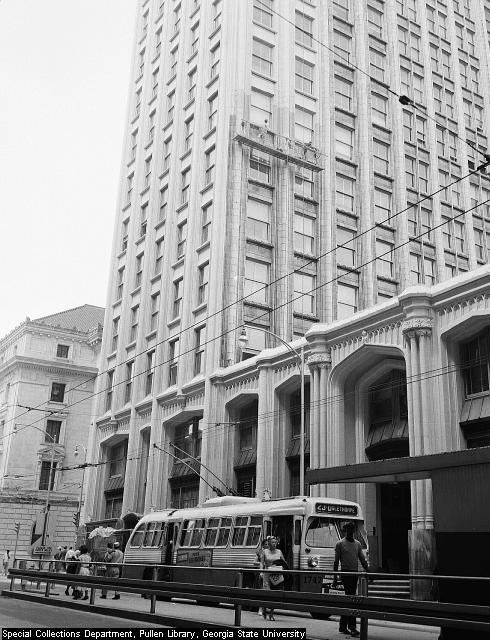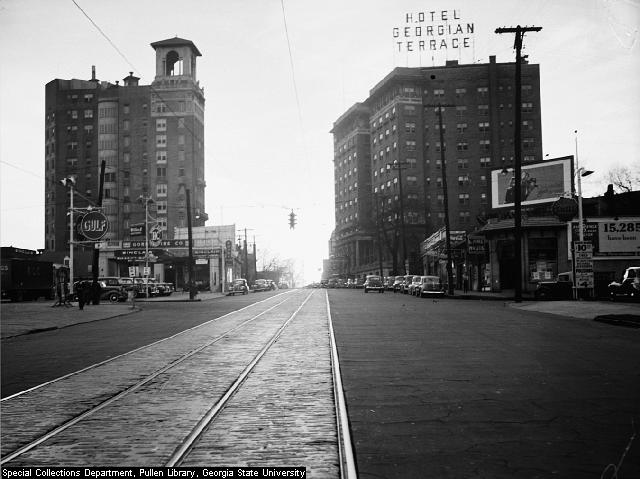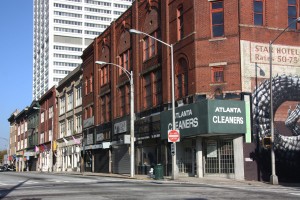
Hotel Row, an architectural gem in south downtown, as seen from the corner of Mitchell and Forsyth Streets. Photo credit: Kristin Halloran.
By Kristin Halloran
Contributing Writer
If you didn’t seize the opportunity last month to go see the Elevate murals on Broad Street, you’re in luck – they’re still there, AND I’m going to tell you all about another reason to visit the neighborhood: the Hotel Row Historic District.
So, everyone knows that Atlanta owes its beginnings to the railroads – zero milepost near Five Points, Western and Atlantic Railroad, Terminus, Nancy Hanks, Silver Comet, etc. etc. If you need a refresher, Wikipedia’s History of Atlanta page is a pretty good start. You can find out more about the Gulch here (watch this space in 2013 for more on Jeff’s tour), and for good measure, read the entertaining tale of a recent search for the relocated milepost here.
Now that we’re all on the same page about what happened in the 19th century, let’s move on. The 20th century came along, and with it came Terminal Station in 1905, designed by P. Thornton Marye, who later worked for the firm that designed the Fox Theatre. Sadly, Terminal Station was demolished in the 1970s, but for many years, it was Atlanta’s largest and busiest train station. And of course, what does a city need near a busy train station? Hotels. And hotels it had. In 1908, a fire destroyed most of the block, creating a perfect opportunity for property owners to provide convenient lodging for rail travelers.
The north side of Mitchell Street between Forsyth and Spring is now known as the Hotel Row Historic District. It was placed on the National Register in 1989, and for good reason. Like Broad Street south of Five Points, this area was more or less ignored when other parts of the city were being redeveloped. Looking on the bright side, that means that it’s retained substantially more of its historic character than the northern part of downtown, where entire blocks were cleared to make space for modern office towers and soaring new hotels. Hotel Row and other intact pockets of the neighborhood are little time capsules, representative of what most of downtown looked like in the early 20th century: sturdy, but not boring, three- to five-story brick buildings with shops and restaurants on the ground floor and offices, residences, or lodging above.

A postcard shows Hotel Row circa 1910.
Starting at the eastern end of the block, where Mitchell intersects Forsyth Street, you’ll find Concordia Hall. On the Forsyth Street side, you can still see old advertisements painted on the brick, right above the gator waiting for a belly rub who was added to the building as part of Living Walls in 2011. You’ll also see the detail that makes these buildings exceptional. Although some of the applied ornament on the front of the building has been removed over the years, the arched windows, fluted pilasters and remaining stone, terra cotta and brick detailing are definitely worth a look.
Concordia Hall is the oldest building in the district – it’s the only one that survived the 1908 fire. The Concordia Association was founded at Morris Rich & Co. (later Rich’s Department Store) on Whitehall Street (now Peachtree Street) to provide social and cultural opportunities for Jewish businessmen, mostly of German and Hungarian descent. The building was designed by Bruce & Morgan, who also did the neo-Gothic Healey Building in Fairlie-Poplar (stay tuned for more on them, too). In 1912, when the Concordia Association was less active, the upper floors were converted to hotel rooms.
Moving west, the next five buildings all date to 1908-1909, shortly after the fire. The Gordon Hotel was designed by one of my favorite Atlanta architects, Willis F. Denny – probably better known for Rhodes Hall and the recently renovated Kriegshaber House, now the home of the Wrecking Bar. (Denny managed to to get a lot done by the time he died at just 31 – I really need to hurry up and design something that will still be standing in another 100 years!) Now Gordon Lofts (yes, you could live there – and there’s a roof deck!), the exterior of the building retains its ground-level stone pilasters, historic windows and Ionic capitals.
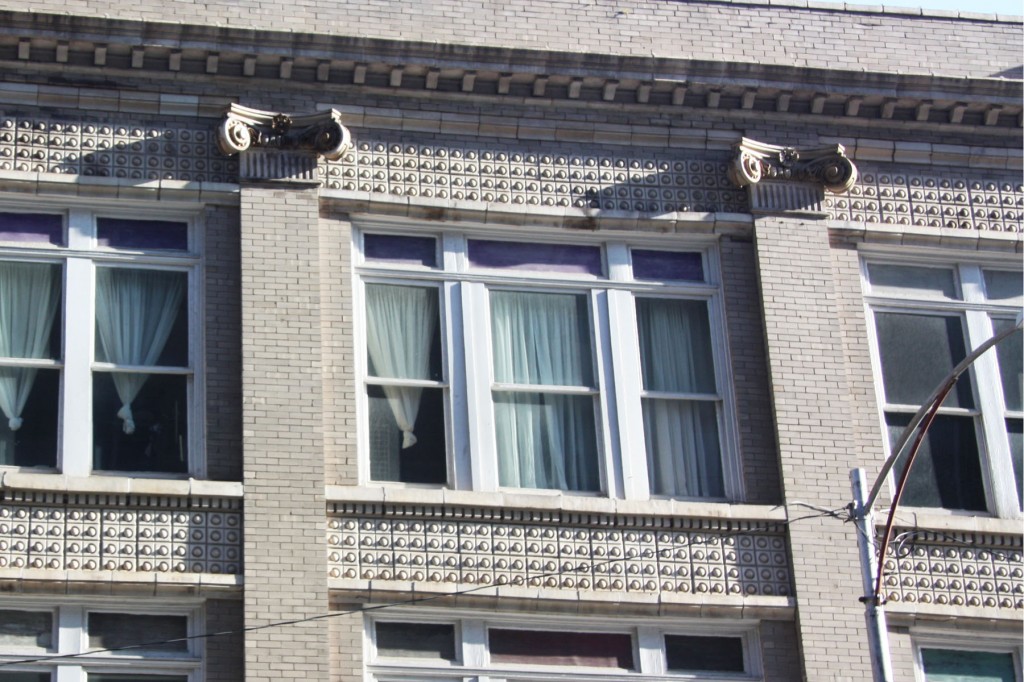
Third-floor windows and Ionic capitals at Gordon Lofts, formerly the Gordon Hotel. Photo credit: Kristin Halloran.
The unnamed commercial building next door is a simple one, solid and elegant. It is separated from the Gordon by an alley, as was common in late 19th- and early 20th-century planning. Most blocks had alleys; Atlanta abandoned nearly all of them in the 1970s. This one now leads to parking for Gordon Lofts.
The Scoville Hotel is next. Plenty of detail is still present on the building’s exterior, and I’ve heard that there are original light fixtures and tile in the lobby. Look for particularly nice stone detailing above the second-floor windows, along with a gabled parapet and a heavy pressed metal cornice with dentils, which are just what they sound like – teeth. The Scoville has been on the market since February. Anyone interested?
The Factory Building is another fairly simple building, also with a heavy cornice. Lunacy Black Market, a favorite haunt of neighbors (like me), is located on the ground floor – Chef Paul Luna (of Loca Luna and Eclipse di Luna fame) opened this eclectic little restaurant after riding his bicycle across the country . It’s friendly and cozy, and there’s not a single thing on the extremely affordable menu of small plates that I haven’t liked. I’ve taken ATLRetro editor Anya99 there, and I think she agreed [Ed. note: yes, I did!]!
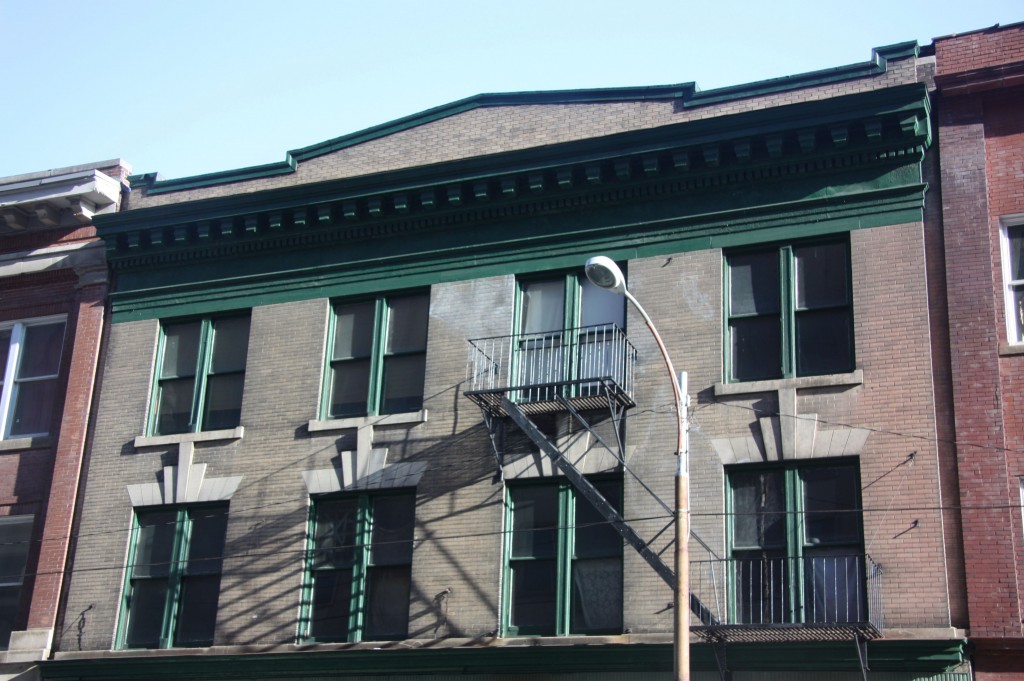
The Scoville Hotel - imagine what the right buyer could do with this place! Photo credit: Kristin Halloran.
Last is the Sylvan Building, which has also been converted to loft apartments. It’s a lovely four-story building that was rehabilitated in the late 1980s with help from Atlanta’s Historic Facade Program. It retains much of its brick detailing, and continues the line of the heavy cornices with parapets above.
Need another reason to visit Hotel Row? Small Business Saturday is coming on Nov. 24! The Atlanta Bicycle Coalition is in the Gordon and a cute new boutique called Girlfriends recently opened nearby. Friedman’s Shoes, a family-owned business that’s been around since 1929, is located in Concordia Hall. My husband buys his shoes there from a salesman named Murray, whose raspy voice and accent might make you wonder if you’ve somehow been transported to Queens. Friedman’s has been well-known for years for its appeal to athletes who take advantage of its large range of sizes, including Shaquille O’Neal, Charles Barkley and Julius Erving. The interior is a fascinating maze – make sure someone sees you go upstairs in case you can’t find your way out! And they do carry women’s shoes, too – I have a neighbor who got a great deal on samples there in size 7!
In addition, the art galleries of Castleberry Hill are just over the bridge, as are the Wine Shoe , a down-to-earth tasting room and wine shop, and No Mas, where you’ll find unique handmade furniture, glassware, jewelry and art objects straight from Mexico.
 Whew. Have I given you enough ideas to fill up an afternoon downtown? If not, here’s one more thing to do in the neighborhood – Atlanta Movie Tours! Both downtown and Castleberry Hill have been overrun with TV and movie crews lately, and some pretty famous stars – I heard that a certain former Governor of California was here earlier this week filming car chases and gunfights that frightened everyone’s pets. Atlanta Movie Tours will let you walk (and ride) in the footsteps of your favorite actors from classic and recent movies filmed downtown and farther afield. ATLRetro readers might be particularly interested in the Big Zombie Tour and can use promo code ATLRETRO for a 25% discount on either of the regularly scheduled tours during December – the Big Zombie Tour or the Big Southern Hollywood Tour. I hope to see you in my neck of the woods soon!
Whew. Have I given you enough ideas to fill up an afternoon downtown? If not, here’s one more thing to do in the neighborhood – Atlanta Movie Tours! Both downtown and Castleberry Hill have been overrun with TV and movie crews lately, and some pretty famous stars – I heard that a certain former Governor of California was here earlier this week filming car chases and gunfights that frightened everyone’s pets. Atlanta Movie Tours will let you walk (and ride) in the footsteps of your favorite actors from classic and recent movies filmed downtown and farther afield. ATLRetro readers might be particularly interested in the Big Zombie Tour and can use promo code ATLRETRO for a 25% discount on either of the regularly scheduled tours during December – the Big Zombie Tour or the Big Southern Hollywood Tour. I hope to see you in my neck of the woods soon!
ATLRetro Contributing Writer Kristin Halloran is a damn Yankee who loves living in downtown Atlanta. She is an architect at Lord Aeck & Sargent, and her favorite things include vintage postcards, old brick buildings and secondhand bookstores.




